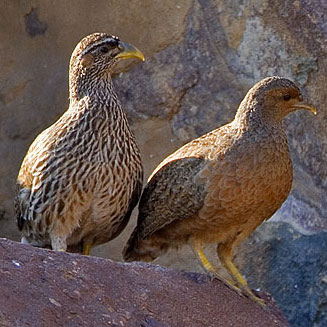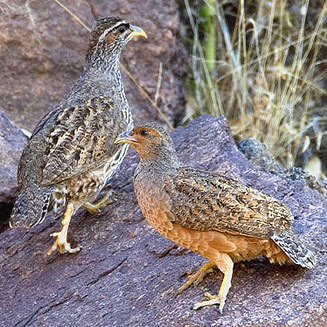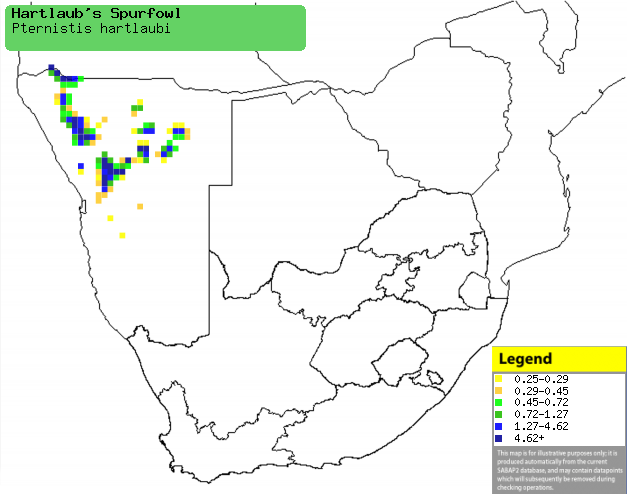|
Pternistis hartlaubi (Hartlaub's
spurfowl, Hartlaub's francolin)
[= Francolinus hartlaubi]
Klipfisant [Afrikaans]; Hartlaub-frankolijn [Dutch]; Francolin de
Hartlaub [French]; Hartlaubfrankolin [German]; Francolim de Hartlaub
[Portuguese]
Life
> Eukaryotes >
Opisthokonta
> Metazoa (animals) >
Bilateria >
Deuterostomia > Chordata >
Craniata > Vertebrata (vertebrates) > Gnathostomata (jawed
vertebrates) > Teleostomi (teleost fish) > Osteichthyes (bony fish) > Class:
Sarcopterygii (lobe-finned
fish) > Stegocephalia (terrestrial
vertebrates) > Tetrapoda
(four-legged vertebrates) > Reptiliomorpha > Amniota >
Reptilia (reptiles) >
Romeriida > Diapsida > Archosauromorpha > Archosauria >
Dinosauria
(dinosaurs) > Saurischia > Theropoda (bipedal predatory dinosaurs) >
Coelurosauria > Maniraptora > Aves
(birds) > Order: Galliformes >
Family: Phasianidae
 |
 |
| Hartlaub's spurfowl male (left) and
female (right), Namibia. [photo
Johann Grobbelaar ©] |
Hartlaub's spurfowl male (left) and female
(right), Namibia. [photo
Johann Grobbelaar ©] |
Identification
Compared to other francolins, the Hartlaub's spurfowl has a
longer, more down-curved bill. In addition, the male can be distinguished by its
white eye stripe and dark cap and the female by the uniform reddish-brown
underparts.
One of the smallest francolins in southern Africa,
averaging 270 g and 230 g in weight for male and female respectively. The Coqui
francolin is arguably lighter (260 g and 240 g respectively), but there is
overlap in weights between the two species.
Distribution and habitat
Patchily distributed through northern Namibia and
south-western
Angola. Found where there are rocky outcrops, or scattered boulders.
|
 |
|
Distribution of Hartlaub's spurfowl in southern Africa,
based on statistical smoothing of the records from first SA Bird Atlas
Project (©
Animal Demography unit, University of
Cape Town; smoothing by Birgit Erni and Francesca Little). Colours range
from dark blue (most common) through to yellow (least common). |
Predators and parasites
Recorded as prey of the African
hawk-eagle.
Food
Mainly eats corms and tubers of small sedges, using its
bill to scrape them out of the ground. The following food items have been
recorded in its diet:
- Plants
- fruit
- bulbs
- seeds
- corms and tubers of small sedges
- Invertebrates
Breeding
- Nest a scrape in the ground lined with dry leaves.
- After laying 2-4 eggs, the female incubates them for
about 23 days before they hatch.
- Chicks can fly short distances at 3 days. They are
fully grown at 165 days.
References
-
Hockey PAR, Dean WRJ and Ryan PG (eds) 2005. Roberts
- Birds of southern Africa, VIIth ed. The Trustees of the John Voelcker
Bird Book Fund, Cape Town.
-
Sinclair, I, Hockey, P. and Tarboton, W. 2002. Sasol
Birds of Southern Africa. 3rd edition. Struik, Cape Town.
Text by Hamish Robertson |
